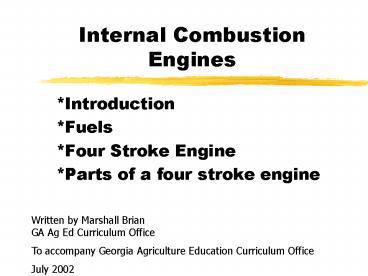Internal Combustion Engines - PowerPoint PPT Presentation
1 / 17
Title:
Internal Combustion Engines
Description:
... take a fuel (gasoline for example) and burn it in an engine to create movement ... all engines use a four-stroke combustion cycle to convert gasoline into ... – PowerPoint PPT presentation
Number of Views:145
Avg rating:3.0/5.0
Title: Internal Combustion Engines
1
Internal Combustion Engines
- Introduction
- Fuels
- Four Stroke Engine
- Parts of a four stroke engine
Written by Marshall Brian
GA Ag Ed Curriculum Office To accompany Georgia
Agriculture Education Curriculum Office July 2002
2
About this Lesson
- This lesson contains hypertext links to
www.howstuffworks.com. - If you are connected to the internet, click on
the link icon and scroll to the animation at the
sight.
3
Introduction
4
Fuels
- Why are nearly all vehicles and engines powered
by gasoline? - extremely high energy density
- cheap (relative to other sources)
- easy and safe to move around
5
Fuels
- Why not use other fuels?
- Size of engines needed to utilize these fuels is
impractical for automobiles lawnmowers etc. - Convenience
- it takes 15 seconds to pump a gallon of gas vs.
several hours to recharge batteries (i.e.
electric cars)
6
Fuels
- What are other types of fuels that can be used?
- Wood- steam engines
- Coal- steam engines
- Oil
- Electricity
7
Internal Combustion
- Where do we get internal combustion?
- The idea here is to take a fuel (gasoline for
example) and burn it in an engine to create
movement of cars and other gas powered machines.
This is where we get internal combustion engines.
8
Internal Combustion
- A cannon uses the basic principles of internal
combustion engines. If you take a small amount
of high energy fuel (like gasoline) in a small,
enclosed space and ignite it, an incredible
amount of energy is released in the form of
expanding gas.
9
The four-stroke cycle
- Almost all engines use a four-stroke combustion
cycle to convert gasoline into motion. - This is also known as the Otto cycle in honor of
Nikolaus Otto who invented it in 1867. - This process takes the basic example of a cannon
several steps further.
10
The four-stroke cycle
- The four stroke combustion cycle consists of
- 1. Intake
- 2. Compression
- 3. Combustion
- 4. Exhaust
11
The four-stroke cycle
- The piston starts at the top, the intake valve
opens and the piston moves down to let the engine
take in a full cylinder of air and gasoline
during the intake stroke
- The piston then moves up to compress the
air/gasoline mixture. This makes the explosion
more powerful.
12
The four-stroke cycle
- When the piston reaches the top, the spark plug
emits a spark to ignite the gasoline/air mixture.
- The gasoline/air mixture explodes driving the
piston down.
- The the piston reaches the bottom of its stroke
the exhaust valve opens and the exhaust leaves
out of the tailpipe. - The engine is ready for another cycle.
13
Parts of an engine
- Cylinder- where the piston moves up and down.
Most lawnmowers are 1 cylinder while automobiles
are 4,6,8, and 10. - Spark plug- supplies spark for the fuel/air
mixture. - Valves- let air in and exhaust out. Note
both valves are closed during the compression
stroke.
14
Parts of an engine
- Piston- cylindrical piece of metal that moves up
and down the cylinder. - Piston rings- rings provide a sliding seal
between the piston and cylinder. - Rings serve two purposes
- prevent fuel/air from leaking into the sump
- prevent oil from entering the combustion chamber
15
Parts of an engine
- Combustion chamber- area where combustion and
compression takes place. - Connecting rod- connects the piston to the
crankshaft. - Crankshaft- the crankshaft turns the up and down
motion of the piston into circular motion - Sump- (oil pan) contains and collects oil for
lubrication
16
Parts of an engine
17
Source
- www.howstuffworks.com

